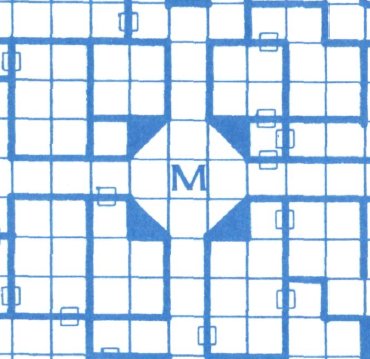
My earlier tweet about language and spoken bandwidth is prompted by some thinking I have been doing about dungeon design. I'm using this image as an example. Let's assume the party is standing at point M with a torch. 

As a DM, you have to describe both the room and the hallways depicted. That includes the location of four doors and three corners. That's a fair amount of info to juggle. How much of that can the players actually process?
We don't often think about a dungeon as an information construct, but that's essentially what it is. A complex dungeon might be frustrating if only because it's a bear to process without drawing out the map as you go.
A simple, somewhat linear dungeon might deliver a smoother, faster experience, though clearly at the cost of player agency. OTOH, if you root agency in a more strategic level (which dungeon do you pick?) you can get around that.
Keep on the Borderlands does this well. The individual Caves of Chaos are kind of dull, but the point is not to make lots of small, interesting dungeons. The real payoff is the open-ended flexibility the adventure offers.
In general, my experience is that communication outside of combat is a bit easier to wrangle. The pace is more leisurely, and tension not as critical to build. However, I also find that outside of combat a detail lost on the players is lost for good, absent a DM reminder.
The approach I'm working on is to treat outside of combat actions as slower, leisurely combat. As a DM, I need to keep options top of mind. I'm leaning toward using more maps/props outside of fights, to help increase data bandwidth.
In 4e and 3e, we did poster maps of encounter areas. In 5e, we do posters of regions. They're aimed at the strategic, non-combat portion of play. This approach also flavored by rebuild of the Nentir Vale.
I want each region to be distinct, both in terms of geography and in narrative importance. Region X is home to villain Y and important to resolve threat Z. When the players are planning, they have a clear, distinct list of places to visit, and reasons to go to each.
Taking this back to the dungeon, consider thinking of a dungeon or similar space along the same lines. You need more flavor and markers to make choices distinct. Use sound and smell along with visuals to make each option different.
Keep information overload in mind. I suspect that more than three options makes things confusing, so consider keeping things simpler or use visual aids to manage non-combat action.
I'm interested in doing research on this - hence asking for sources - but I don't think it's a factor that tabletop designers have paid much mind to. Which is surprising, given how critical spoken communication is for TRPG play.
For myself, this leads to what be something of a funny reversal - minis and a grid for non-combat dungeon exploration, shifting to theater of the mind when a fight breaks out. It's not a place where I expected to end up, but I'm going to try it in my Friday campaign.
• • •
Missing some Tweet in this thread? You can try to
force a refresh



